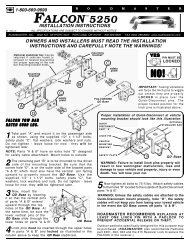tow bars - Roadmaster Inc.
tow bars - Roadmaster Inc.
tow bars - Roadmaster Inc.
Create successful ePaper yourself
Turn your PDF publications into a flip-book with our unique Google optimized e-Paper software.
Anti-sway <strong>bars</strong><br />
Does your motorhome handle like the Queen<br />
Mary? Does it pitch and roll with every gust of<br />
wind or passing semi, or list to port or starboard<br />
on the curves, or waddle over speed bumps, railroad<br />
tracks and driveways?<br />
Well, it shouldn’t. As a matter of fact, motorhomes<br />
(as well as SUVs, pickup trucks and vans) can be made<br />
to handle just like what they are — motor vehicles —<br />
with two aftermarket upgrades.<br />
Upgrading your shock absorbers will control up and<br />
down motion. But the best shocks in the world won’t<br />
affect side to side motion (the “Queen Mary effect,”<br />
commonly called “body roll” or “sway”) by one iota.<br />
The solution to sway is in the suspension.<br />
Adding a set of custom anti-sway <strong>bars</strong> to your suspension<br />
system will have the<br />
same effect on sway as a<br />
good set of shocks has on up<br />
and down motion — there’s<br />
an immediate improvement<br />
in stability and tracking, es-<br />
pecially on the curves.<br />
For many motorhome<br />
owners, this is an empowering<br />
experience. What was<br />
beyond their control, just yesterday,<br />
is suddenly within it<br />
— cornering with confidence,<br />
quicker maneuvering, and a remarkably level ride over<br />
uneven terrain — all without launching the dishes out<br />
of the cupboard. And even after eight or 10 hours at<br />
the wheel, they arrive fresh, instead of fatigued. Which<br />
means they can start enjoying the Grand Canyon, the<br />
Grand Tetons, or the grandkids right away.<br />
How could one component<br />
have such a dramatic effect?<br />
Both stock and custom anti-sway <strong>bars</strong> are designed<br />
as a link between the suspension and the frame, and<br />
both use the weight of the axle as a brace against the<br />
chassis, so that pressure to one side of the motorhome<br />
(by weight shift, crosswinds or passing trucks) is countered<br />
by the bar.<br />
A custom anti-sway bar, however, is built to offer<br />
significantly more resistance to sway…<br />
• Bigger is better — custom anti-sway <strong>bars</strong> have<br />
a thicker diameter than stock <strong>bars</strong>. Often, a quarter<br />
to three-eighths of an inch more. Each incremental<br />
increase in diameter has an exponential effect on<br />
performance — on average, torsional roll stiffness is<br />
increased by 30 percent with every 1/8” increase in<br />
diameter.<br />
In plain English, the bar offers 30% more resistance<br />
to sway.<br />
• A high-grade alloy — custom anti-sway <strong>bars</strong><br />
are made of 4140 “chromoly” steel (a chrome and<br />
54<br />
RSS<br />
stock<br />
Bigger is better — the RSS anti-sway bar (to the<br />
left) has a larger diameter, a better grade of steel and<br />
polyurethane bushings, making it much more resistant<br />
to sway than a stock anti-sway bar (right).<br />
Towing and Suspension Solutions<br />
molybdenum alloy), which is considerably more durable<br />
than the standard spring steel (a 1020 grade) used in<br />
many stock sway <strong>bars</strong>.<br />
• A better pivot point — all anti-sway <strong>bars</strong> pivot and<br />
rotate, in response to pressure shifts on the chassis. The<br />
bushings (one at each connecting point) are the pivot<br />
points, and also the points most vulnerable to abrasion.<br />
Stock bushing are made of rubber, which hardens<br />
over time, making it more susceptible to abrasion. Rubber<br />
is also subject to corrosion, and additional wear,<br />
from petroleum products such as gasoline or oil, and<br />
from ozone in the atmosphere.<br />
The more a stock bushing<br />
wears, the more the sway<br />
bar ‘gives.’ Over time, the<br />
motorhome leans farther<br />
and farther out of line, in<br />
response to the same load<br />
weights. That’s what causes<br />
driver fatigue on big rigs —<br />
constantly correcting for<br />
excessive sway.<br />
RSS bushings, on the othher<br />
hand, are made of polyurethane,<br />
which has many<br />
advantages over rubber — polyurethane is impervious to<br />
gas, oil and ozone corrosion, is more resistant to abrasion,<br />
and doesn’t buckle under heavier load weights.<br />
RSS anti-sway bar benefits<br />
• improved handling<br />
• increased stability<br />
• reduced body roll<br />
• a safer and smoother ride<br />
• combats crosswinds<br />
• corner with confidence<br />
• less driver fatigue<br />
• improvement over factory standard equipment<br />
Designed to fit specific…<br />
• Class A and C motorhomes • SUVs • Trucks • Vans<br />
What do our customers say?<br />
“I noticed a difference as soon as I stepped into the<br />
motorhome — there was no rocking movement.<br />
During a recent trip we encountered substantial crosswinds.<br />
With the RSS anti-sway bar, I estimate our motorhome’s<br />
sway was reduced by 90 percent.<br />
We don’t feel anything now when a tractor trailer blows<br />
by us.<br />
I’m 100 percent satisfied — everyone should experience<br />
the benefit of this product.”<br />
— Johnny Singleton, Myrtle Beach, South Carolina





